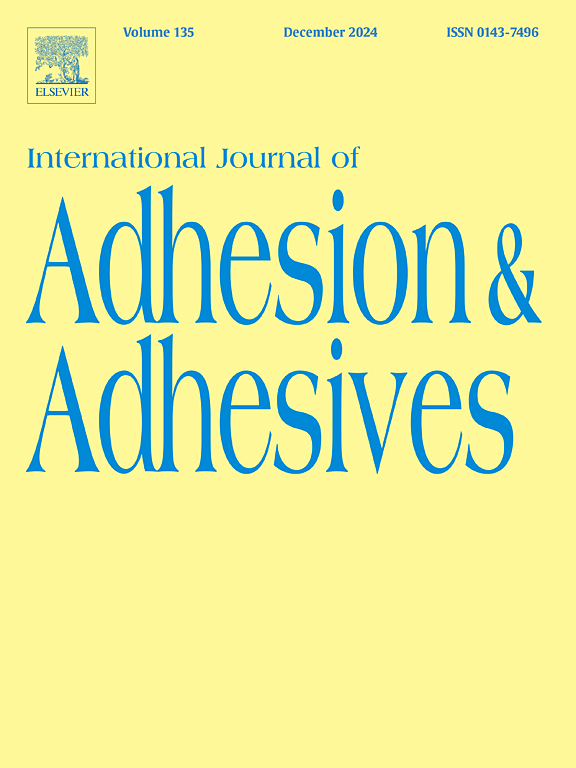Effect of aluminum hydroxide on the physical, mechanical, and fire-resistant properties of Acacia mangium waste/polyurethane particleboards
IF 3.5
3区 材料科学
Q2 ENGINEERING, CHEMICAL
International Journal of Adhesion and Adhesives
Pub Date : 2025-10-06
DOI:10.1016/j.ijadhadh.2025.104174
引用次数: 0
Abstract
The growing demand for sustainable materials has driven the use of agricultural residues, such as Acacia mangium waste, in composite particleboard production. These boards are widely utilized in furniture, construction, and packaging due to their affordability and versatility. However, high flammability limits their broader industrial application. This study investigates the incorporation of aluminum hydroxide (Al(OH)3) as a fire-retardant filler in Acacia mangium waste/polyurethane-based particleboards. The objective was to evaluate how varying Al(OH)3 concentrations affect the physical, mechanical, thermal, and fire-resistant properties of the composites. Acacia mangium waste-based particleboards were prepared with different Al(OH)3 loadings 0–7.5 wt% Al(OH)3 to improve fire resistance while maintaining physical and mechanical performance. Particleboards were tested for water absorption (WA), modulus of rupture (MOR), and modulus of elasticity (MOE). Thermogravimetric analysis (TGA) and limiting oxygen index (LOI) tests assessed thermal stability and fire retardancy. Results showed improved water resistance, with WA reduced to 11.2 %, and a maximum MOE of 5174.5 MPa at 6 % Al(OH)3. However, MOR decreased from 23.6 MPa (0 wt% Al(OH)3) to 18.5 MPa at 6 % Al(OH)3., indicating a trade-off between stiffness and rupture strength. TGA revealed that the third-stage maximum mass-loss temperature increased from 349.01 °C (0 wt% Al(OH)3) to 394.18 °C at 6 wt% (+45.17 °C) and to 410.28 °C at 7.5 wt% (+61.27 °C), indicating enhanced thermal stability. and 6 wt% formulation achieved a LOI of 23 %, meeting the slow-burn criterion. Statistical analysis (ANOVA and Tukey HSD) confirmed the significant influence of Al(OH)3 on all properties. The findings highlight that 6 % Al(OH)3 offers an optimal balance between mechanical integrity and fire resistance. This formulation meets international strength standards and provides enhanced durability, making it suitable for applications requiring both flame retardancy and moisture resistance.
氢氧化铝对相思废/聚氨酯刨花板物理、机械和耐火性能的影响
对可持续材料日益增长的需求推动了农业残留物的使用,如金合欢锰废料,用于复合刨花板生产。这些板被广泛应用于家具、建筑和包装,因为它们的价格实惠和多功能性。然而,高可燃性限制了其更广泛的工业应用。本研究研究了氢氧化铝(Al(OH)3)作为阻燃填料掺入相思废料/聚氨酯基刨花板。目的是评估不同的Al(OH)3浓度如何影响复合材料的物理、机械、热学和防火性能。制备了不同Al(OH)3负荷量0-7.5 wt% Al(OH)3的相思锰渣刨花板,以提高抗火性,同时保持物理和机械性能。测试了刨花板的吸水率(WA)、断裂模量(MOR)和弹性模量(MOE)。热重分析(TGA)和极限氧指数(LOI)测试评估了热稳定性和阻燃性。结果表明,当Al(OH)3含量为6%时,水性降低至11.2%,最大MOE为5174.5 MPa。然而,MOR从23.6 MPa (0 wt% Al(OH)3)下降到18.5 MPa (6% Al(OH)3)。表明了在刚度和断裂强度之间的权衡。TGA表明,第三阶段的最大失重温度从349.01°C (0 wt% Al(OH)3)增加到394.18°C (6 wt% +45.17°C)和410.28°C (7.5 wt% +61.27°C),表明热稳定性增强。6 wt%配方的LOI达到23%,符合慢燃标准。统计分析(ANOVA和Tukey HSD)证实了Al(OH)3对所有性能的显著影响。研究结果强调,6%的Al(OH)3提供了机械完整性和耐火性之间的最佳平衡。该配方符合国际强度标准,并提供增强的耐久性,使其适用于需要阻燃性和防潮性的应用。
本文章由计算机程序翻译,如有差异,请以英文原文为准。
求助全文
约1分钟内获得全文
求助全文
来源期刊

International Journal of Adhesion and Adhesives
工程技术-材料科学:综合
CiteScore
6.90
自引率
8.80%
发文量
200
审稿时长
8.3 months
期刊介绍:
The International Journal of Adhesion and Adhesives draws together the many aspects of the science and technology of adhesive materials, from fundamental research and development work to industrial applications. Subject areas covered include: interfacial interactions, surface chemistry, methods of testing, accumulation of test data on physical and mechanical properties, environmental effects, new adhesive materials, sealants, design of bonded joints, and manufacturing technology.
 求助内容:
求助内容: 应助结果提醒方式:
应助结果提醒方式:


